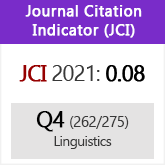Monitoring Parkinson Disease from speech articulation kinematics
DOI:
https://doi.org/10.3989/loquens.2017.036Keywords:
neuromotor deterioration, Parkinson Disease speech, hypokinetic dysarthria, speech articulation modeling, speech neuromechanicsAbstract
Parkinson Disease (PD) is a neuromotor illness affecting general movements of different muscles, those implied in speech production being among them. The relevance of speech in monitoring illness progression has been documented in these last two decades. Most of the studies have concentrated in dysarthria and dysphonia induced by the syndrome. The present work is devoted to explore how PD affects the dynamic behavior of the speech neuromotor biomechanics (neuromechanics) involved in deficient articulation (dysarthria), in contrast to classical measurements based on static features as extreme and central vowel triangle positions. A statistical distribution of the kinematic velocity of the lower jaw and tongue is introduced, which presents interesting properties regarding pattern recognition and classification. This function may be used to establish distances between different articulation profiles in terms of information theory. Results show that these distances are correlated with a set of tests currently used by neurologists in PD progress evaluation, and could be used in elaborating new speech testing protocols.
Downloads
References
Carmona-Duarte, C., Alonso, J. B., Díaz, M., Ferrer, M. A., Gómez-Vilda, P., & Plamondon, R. (2016). Kinematic modelling of diphthong articulation. In A. Esposito et al. (Eds.), Recent advances in nonlinear speech processing, Vol. 48, 53?60. Cham: Springer. https://doi.org/10.1007/978-3-319-28109-4_6
Cecchi, G. (2017). With AI, our words will be a window into our mental health. Retrieved from https://www.ibm.com/blogs/research/2017/1/ibm-5-in-5-our-words-will-be-the-windows-toour-mental-health/
Cover, T. M., & Thomas, J. A. (2006). Elements of information theory. New York: Wiley.
CSL (2017). Computerized Speech Lab. https://www.pentaxmedical. com/pentax/en/94/1/Visi-Pitch-IV-Model-3950BComputerized-Speech-Lab-CSL-Model-4500-and-4150B.
Démonet, J. F., Thierry, G., & Cardebat., D. (2005). Renewal of the Neurophysiology of Language: Functional Neuroimaging. Physiological Reviews, 85, 49-95. https://doi.org/10.1152/physrev.00049.2003 PMid:15618478
Dromey, C., Jang, G. O., & Hollis, K. (2013). Assessing correlations between lingual movements and formants. Speech Communication, 55(2), 315-328. https://doi.org/10.1016/j.specom.2012.09.001
Fénelon, G., Mahieux, F., Huon, R., & Ziégler, M. (2000). Hallucinations in Parkinson's disease. Prevalence, phenomenology and risk factors. Brain, 123(4), 733-745. https://doi.org/10.1093/brain/123.4.733 PMid:10734005
Gamboa, J., Jiménez-Jiménez, F. J., Nieto, A., Montojo, J., Ortí-Pareja, M., Molina, J. A., … Cobeta, I. (1997). Acoustic voice analysis in patients with Parkinson's disease treated with dopaminergic drugs. Journal of Voice, 11(3), 314-320. https://doi.org/10.1016/S0892-1997(97)80010-0
Gerard, J. M., Perrier, P., & Payan, Y. (2006). 3D biomechanical tongue modeling to study speech production. In Speech Production: Models, Phonetic Processes, and Techniques, New York; Psychology Press, chapter 6, 85-102.
Goetz, C. G., Fahn, S., MartinezMartin, P., Poewe, W., Sampaio, C., Stebbins, G. T., … LaPelle, N. (2007). Movement Disorder Societysponsored revision of the Unified Parkinson's Disease Rating Scale (MDSUPDRS): Process, format, and clinimetric testing plan. Movement Disorders, 22(1), 41-47. https://doi.org/10.1002/mds.21198 PMid:17115387
Gómez, P., Palacios, D., Rodellar, V., Álvarez, A., Nieto, V., & Martínez, R. (2017a). Parkinson's disease monitoring by biomechanical instability of phonation. Neurocomputing, 255, 3-16. https://doi.org/10.1016/j.neucom.2016.06.092
Gómez-Vilda, P., Palacios-Alonso, D., Gómez-Rodellar, A., Ferrández-Vicente, J. M., Álvarez-Marquina, A., Martínez-Olalla, R., & Nieto-Lluis, V. (2017b). Relating facial myoelectric activity to speech formants. In J. M. Ferrández Vicente, J. R. Álvarez- Sánchez, F. de la Paz López, J. Toledo Moreo & H. Adeli (Eds.), Proceedings of IWINAC 2017 LNCS 10338, Vol. 2 (pp. 520-530). Cham: Springer. https://doi.org/10.1007/978-3-319-59773-7_53
Hoehn, M. M., & Yahr, M. D. (1967). Parkinsonism: onset, progression, and mortality. Neurology, 17(5), 427-442. https://doi.org/10.1212/WNL.17.5.427 PMid:6067254
International Phonetic Association (2005). IPA Chart. Retrieved from http://www.internationalphoneticassociation.org/content/ ipa-chart
Mekyska, J., Janousova, E., Gomez-Vilda, P., Smekal, Z., Rektorova, I., Eliasova, I., … López-de-Ipi-a, K. (2015). Robust and complex approach of pathological speech signal analysis. Neurocomputing, 167, 94-111. https://doi.org/10.1016/j.neucom.2015.02.085
Mertens, C., Schoentgen, J., Grenez, F., Skodda, S., & Manfredi, C. (2013). Acoustical analysis of vocal tremor in Parkinson speakers. Proceedings of MAVEBA, 13, 19-22.
NIST/SEMATECH (2015). NIST/SEMATECH e-Handbook of Statistical Methods. Retrieved from http://www.itl.nist.gov/div898/handbook/
Orozco-Arroyave, J. R., Belalcazar-Bola-os, E. A., Arias-Londo-o, J. D., Vargas-Bonilla, J. F., Skodda, S., Rusz, J., … Nöth, E. (2015). Characterization Methods for the Detection of Multiple Voice Disorders: Neurological, Functional, and Laryngeal Diseases. IEEE Journal of Biomedical and Health Informatics, 19(6), 1820-1828. https://doi.org/10.1109/JBHI.2015.2467375 PMid:26277012
Pérez-Lloret, S., Negre-Pages, L., Damier, P., Delval, A., Derkinderen, P., Destée, A., …Rascol, O. (2014). Prevalence, determinants, and effect on quality of life of freezing of gait in Parkinson disease. JAMA Neurology, 71(7), 884-89. https://doi.org/10.1001/jamaneurol.2014.753 PMid:24839938
Sanguineti, V., Laboissière, R., & Payan, Y. (1997). A control model of human tongue movements in speech. Biological Cybernetics, 77(1), 11-22. https://doi.org/10.1007/s004220050362 PMid:9309860
Sapir, S. (2014). Multiple factors are involved in the dysarthria associated with Parkinson's disease: A review with implications for clinical practice and research. Journal of Speech, Language, and Hearing Research, 57(4), 1330-1343. https://doi.org/10.1044/2014_JSLHR-S-13-0039 PMid:24686571
Sapir, S., Ramig, L. O., Spielman, J. L., & Fox, C. (2010). Formant centralization ratio: A proposal for a new acoustic measure of dysarthric speech. Journal of Speech, Language and Hearing Research, 53, 114-125. https://doi.org/10.1044/1092-4388(2009/08-0184) PMCid:PMC4504121
Stiasny-Kolster, K., Sixel-Döring, F., Trenkwalder, C., Heinzel-Gutenbrunner, M., Seppi, K., Poewe, W., … Frauscher, B. (2015). Diagnostic value of the REM sleep behavior disorder screening questionnaire in Parkinson's disease. Sleep Medicine, 16(1), 186-189. https://doi.org/10.1016/j.sleep.2014.08.014 PMid:25534709
Ziemssen, T., & Reichmann, H. (2007). Non-motor dysfunction in Parkinson's disease. Parkinsonism & Related Disorders, 13(6), 323-332. https://doi.org/10.1016/j.parkreldis.2006.12.014 PMid:17349813
Published
How to Cite
Issue
Section
License
Copyright (c) 2017 Consejo Superior de Investigaciones Científicas (CSIC)

This work is licensed under a Creative Commons Attribution 4.0 International License.
© CSIC. Manuscripts published in both the printed and online versions of this Journal are the property of Consejo Superior de Investigaciones Científicas, and quoting this source is a requirement for any partial or full reproduction.All contents of this electronic edition, except where otherwise noted, are distributed under a “Creative Commons Attribution 4.0 International” (CC BY 4.0) License. You may read here the basic information and the legal text of the license. The indication of the CC BY 4.0 License must be expressly stated in this way when necessary.
Self-archiving in repositories, personal webpages or similar, of any version other than the published by the Editor, is not allowed.















